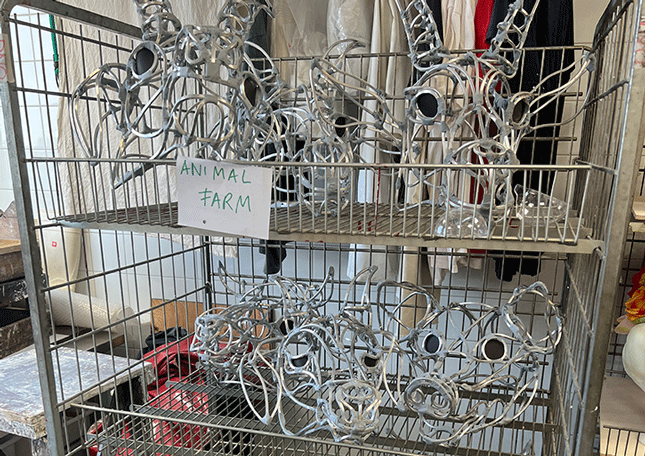
The Masks for Animal Farm
In March, during the opera adaptation of George Orwell’s famous book Animal Farm, 35 soloists and choral singers will take on the roles of the rebellious farm animals from this literary classic. The masks needed for this transformation are being made in Dutch National Opera & Ballet’s milliners’ workshop.
Text: Rosalie Overing
While the finishing touches are being put on the skulls for Barrie Kosky’s new production of Turandot at the table next to him, Ton Joling – head of the milliners’ and costume department – is already busy preparing for the opera Animal Farm, which makes its world premiere on 3 March. A cow’s head and two and a half horses’ heads stare back from the three silver frames standing in front of him. To the side is a bulging folder of sketches, photos and notes. “That’s where the whole process begins,” Ton tells us. “The costume designer sends us all kinds of material and explains what they want. Using this, we then show them a number of samples.”
(Un)realistic
However, the final result is often very different from the original designs. This was also the case with the masks for Animal Farm. Ton: “Initially, the designer wanted the masks, like the rest of the set and props, to look as realistic as possible. So, for example, we received a picture of someone wearing a very realistic-looking pig’s head, with thick skin. But try singing in one of those – impossible!”
Another example the designer gave were the horses from the musical production War Horse: mesh-covered frames operated on stage by multiple puppeteers. Ton: “Despite moving just like real horses, those puppets look very unrealistic. To bring this home to the designer, I made a horse’s head in the same style. His response: ‘Yes, it’s unrealistic, but I really like it’. So now we’re making the rest of the masks like that, too.”
Real rust
The frames of the masks for Animal Farm are made from square rods of solid aluminium. By shaping the material to add details to nostrils, eyes, eyebrows, horns and ears, Ton makes each mask unique. “Each animal has its own character,” he explains. “For example, I made a happy smiling pig but also a more evil one, with lower eyebrows and a mean grin.”
Most of the frames are now finished and ready to go to the dye shop, where they will be in the competent hands of dyer Rosalinda Lourens and her colleagues. Rosalinda: “The animals in the opera are in a kind of concentration camp, which is why the heads have to look rusty. Since aluminium itself doesn’t rust, we first smear the frame with paint containing iron particles. Acid is then added to this, which causes the iron particles to rust. Although in some cases we have to touch things up with a bit of brown paint, it’s largely real rust.”
‘The masks have a big impact on the way the singers move on stage’
Through other eyes
Ton and his team cover the ‘rusty’ frames with transparent gauze, which is then painted again in the dye shop. Black-painted half-spheres are placed where the eyes should be. However, this doesn’t mean that the wearer of the mask will feel like they’re looking through sunglasses: “Because the eyes of an animal are in a very different place to the eyes of a human being,” say Ton and Rosalinda, laughing. “We’re asked about that a lot, but the singers just look straight ahead, through the transparent mesh.”
Although the premiere of Animal Farm is not until March, the deadline for Ton and Rosalinda’s teams is much sooner. Ton: “The masks have a big impact on the way the singers move on stage, so they need to have enough time to get used to them. That’s why they have to be ready before rehearsals start. Stretching the mesh alone can take two whole days, so we’re going to have to work very hard to get it all finished on time!”
WANT TO SEE THE FINAL RESULT?
Animal Farm can be seen at Dutch National Opera from 3 to 16 March
